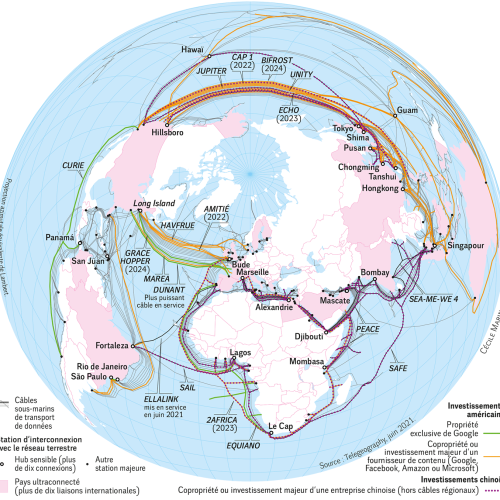DIGITAL ECOLOGY
Digital technology, with its tools and services, has very tangible impacts on the environment: resource extraction, soil pollution, waste, greenhouse gas emissions, and more. This is often overlooked due to increasingly sophisticated marketing terms (clouds, virtual worlds, etc.) that present it as immaterial.
The internet operates through a colossal infrastructure of submarine cables (click here to access the interactive map). These cables are at the heart of a fierce battle between nations (led by the United States and China) and tech giants like Google, Amazon, Facebook, and Microsoft. The stakes are high in terms of sovereignty, security, and intelligence.
What Role Do Data Play in All This?
Data fuel the digital world. They are pieces of information stored on physical devices (chips, servers, etc.) whose installation, logistics, and maintenance require enormous resources, particularly for cooling data centers. Without delving into technical details, this can be achieved in various ways, such as using air conditioners, chilled water, or immersion in a dielectric fluid.
This page aims to raise awareness about the ecological challenges of digital technology, complementing our various projects.
The ecological issues related to digital technology grow in proportion to its development and usage. It is important to note that most of the negative environmental impacts stem from the manufacturing of devices, driven by large industries.
The consequences include :
- An increase in the extraction of mineral resources required for the production of digital equipment.
- Soil pollution caused by these extractions.
- A rise in energy consumption (logistical management of infrastructure, device charging, etc.).
- A surge in waste due to the planned obsolescence of certain devices and/or the push to consume new ones.
To better emphasize the tangible nature of digital technology and contribute, to some extent, to reducing its impact, we present here a “digital lifecycle” covering everything from the manufacturing and use of your electronic devices to their recycling.
This cycle, detailed below, will help you reduce your ecological footprint and protect your personal data.
Far from being exhaustive or perfect, the main goal here is to help you visualize and understand both the impacts of digital technology (massive extraction of rare metals, water consumption, etc.) and the existing alternatives.
Note: We have included many links within our descriptions to help you learn more about the topics discussed.
1 | Manufacturing
- Opt for refurbished devices (phones, computers, televisions, tablets, etc.).
- Choose a de-Googled device or install a de-Googled operating system(OS)
2 | Usage
- Prefer Wi-Fi over 4G or 5G, which consumes more energy.
- Download content (videos, podcasts) instead of using streaming services.
- Use lighter services (that also respect your privacy!).
- Avoid charging your phone overnight to reduce battery deterioration and increase its lifespan.
- Regularly clean up emails, photos, and documents to reduce the storage space they occupy on servers.
- Store data on an external hard drive.
- Use apps and their features (e.g., likes) sparingly.
- Avoid using ChatGPT or other generative AI for simple queries.
- Prefer Progressive Web Apps (PWAs) to preserve your phone’s storage space and reduce data leaks associated with app downloads.
3 | Recycling
Solutions exist to help you donate or recycle your electronic devices.
CONCLUSION
No click is insignificant. The communication power of Big Tech (GAFAM) through their supposedly ecological rhetoric (greenwashing) is nothing more than a deceptive illusion that we must guard against.
Sorting, deleting your data, and using digital tools responsibly are concrete ways to positively impact your digital carbon footprint.
P.S.: Feel free to raise awareness among your friends and colleagues by sharing this page with them!



